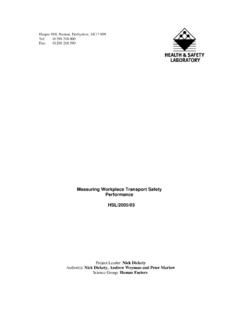Transcription of OFFSHORE TECHNOLOGY REPORT 2000/048 - …
1 HSEH ealth & SafetyExecutiveBehaviour modification programmesestablishing best practicePrepared byThe Keil Centrefor the Health and safety ExecutiveOFFSHORE TECHNOLOGY REPORT2000/048 Crown copyright 2001 Applications for reproduction should be made in writing to:Copyright Unit, Her Majesty s Stationery Office,St Clements House, 2-16 Colegate, Norwich NR3 1 BQFirst published 2001 ISBN 0 7176 1920 6 All rights reserved. No part of this publication may bereproduced, stored in a retrieval system, or transmittedin any form or by any means (electronic, mechanical,photocopying, recording or otherwise) without the priorwritten permission of the copyright REPORT is made available by the Health and SafetyExecutive as part of a series of reports of work which hasbeen supported by funds provided by the Executive andBP Amoco.
2 Neither the Executive, nor the contractorsconcerned assume any liability for the reports nor do theynecessarily reflect the views or policy of the & SafetyExecutiveBehaviour modification programmesestablishing best practiceMark Fleming and Ronny LardnerChartered PsychologistsThe Keil Centre5 South Lauder RoadEdinburghEH9 9 LJHSE BOOKS2 Table of THIS STUDY BEHAVIOUR MODIFICATION programme STUDY OUT FOR safety BP AMOCO S ANDREW of safe / unsafe baseline on safety safety AUDITING BP AMOCO S of safe / unsafe baseline on safety OF STOP programme
3 CONOCO ( ) of safe / unsafe baseline example of a STOP on safety CARE PLUS SHELL S CORMORANT ALPHA of safe / unsafe baseline on safety OVERALL SUMMARY OF THE FOUR CASE STUDIES2412. CONCLUSIONS2651. Executive summaryOffshore oil and gas companies are making increasing use of behaviour modificationprogrammes, which are designed to improve safety by modifying worker behaviour. Reportson the success of these programmes vary from dramatic reductions in accident rates to nochange and or worker disillusionment.
4 There is a shortage of clear, readable and impartialinformation, to assist those purchasing and implementing behavioural modificationprogrammes. In order to address this issue, four case studies were carried out to provideinformation about the range of programmes currently being used and identify barriers andenablers associated with these behaviour modification programmes. The four programmesare Time Out For safety (TOFS), Advanced safety Auditing (ASA), STOP and Care case study involved interviewing both onshore and OFFSHORE managers and installationemployees.
5 Accident statistics were reviewed to assess the impact of these programmes was developed by the drilling crew on the BPAmoco s Andrew platform, in responseto some of the challenges they were facing. Over time it has been adopted by the entireplatform, and more recently by other installations. TOFS is effective because it is designed tomodify an important behaviour of frontline employees, namely stopping the job if they haveany safety concerns. It is simple, as it does not require employees to complete forms, whichalso reduces anxiety about colleagues being reprimanded for their actions.
6 The successfulintroduction of TOFS on the Andrew platform was partially due to the positive safety culturethe installation s already had at the time TOFS was has provided an additional means for management on BPAmoco s Miller platform tomake a visible, tangible commitment to safety . They do this by conducting ASA sthemselves, providing ASA training for most of their workforce, and opening up their ownmanagerial work practices by inviting all staff to conduct an ASA on them. What began as amanagement tool has been widened to include all core employees, and ownership of ASA hasthus been relaunched their STOP programme to address employee concerns about itseffectiveness and implementation.
7 Conoco management regard the relaunch of STOP as asuccess. Managers and supervisors participation in the programme has been enhanced, andthey believe they have now enlisted the core crew s acceptance of STOP. Core crew nowunderstand that via STOP they can make a real contribution to safety with very littleadditional time and Plus is a complex behavioural intervention, which includes all the major features ofbehaviour modification. There appears to be a strong sense of ownership for the programmeamong the workforce.
8 The programme seems to have a momentum and life of its ownbecause it has endured, although many of the initial volunteers and champions have left theplatform. The acceptance of Care Plus by the majority of the workforce has been a majorachievement. The programme has been fully operational for less than 12 months, yet therehas already been a reduction in frequency rate of first aid cases. The criteria for the successfor this type of intervention are management commitment, trust between all staff andemployees who are interested in safety and willing to take ownership of their own four case studies highlight a number of enablers and barriers that are commonlyencountered when implementing a behavioural safety initiative.
9 The preconditions requiredbefore implementing a behavioural safety initiative are About this reportThis REPORT will assist the reader in designing, implementing and improving safety behaviourmodification programmes. In addition, it will provide the HSE, including OFFSHORE inspectorswith knowledge and information to advise the industry on this important topic and enablethem to make informed decisions about the impact these programmes are having on safety inthe OFFSHORE oil IntroductionOffshore oil and gas companies are making increasing use of behaviour modificationprogrammes, which are designed to improve safety by modifying worker behaviour.
10 Acomprehensive literature review1 was carried out to explain the underpinning theory andeffectiveness of behaviour modification. The review also identified a range of barriers andenablers to the success of behaviour modification programmes. The results of the reviewindicated that additional research was required to provide adequate guidance on the selection,implementation and effectiveness of these programmes in an OFFSHORE modification programmes, which address safety , typically involve some form ofworkplace observation of unsafe acts or conditions, with a procedure for follow-up action andreporting system.















